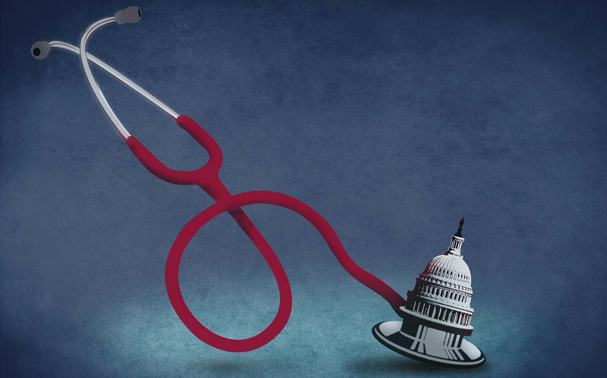by Marilyn M. Singleton, MD, JD
The new Medicare for All bill (H.R. 1384) has come and hopefully will go the way of the pet rock. Everybody now knows the basics: the government will take care of all medical, dental, vision, pharmacy, and long-term care services with no out-of-pocket expenses. The bill prohibits parallel private insurance, and has the glaring absence of a financing mechanism.
But as usual, bills contain hidden gems. Section 104 of the bill tracks the Affordable Care Act’s “anti-discrimination” rule, making it clear that no person can be denied benefits, specifically including abortion and treatment of gender identity issues “by any participating provider.” The bill does not correspondingly reaffirm the federal laws protecting conscience and First Amendment religious freedom rights of medical personnel. Such protections relate to participation in abortion, sterilization, assisted suicide, and other ethical dilemmas.
Most sane individuals agree that we do not want our government to control any aspect of our individual lives—particularly not our religious beliefs and moral codes. When the Department of Health and Human Services (HHS) sought to clarify such conscience protections, thousands of commenters offered evidence of discrimination and coercion to violate the tenets of the Oath of Hippocrates and their own ethics. Some left their jobs or left the medical profession entirely when their conscientious objections were not honored.
Conscience protections are vital in this time of unabashed devaluing of life. Last year, the Palliative Care and Hospice Education Training Act (PCHETA), passed the House but died in the Senate. This bill would have dedicated $100 million in additional taxpayer dollars to persuade patients to forgo treatment that might prolong life in exchange for a steady stream of increasing doses of narcotics. Already some families feel they are not merely offered hospice as a choice but are steered toward it when their older relatives fall ill, even when the medical prognosis is uncertain.
The focus on palliative care and lowering costs by reducing “aggressive” end-of-life treatment is one more incremental under-the-radar step along the road to government control over life and death. A culture of hastening death has gradually evolved, disguised as “death with dignity.” California, Colorado, Oregon, Washington, Montana, Vermont have legalized physician-assisted suicide with 20 other states considering implementing such laws.
Subtly devaluing life primes the pump for rationing of medical care at all stages by a government-run program that is the exclusive purveyor of medical “benefits.” Our western counterparts with single payer have discovered that offering fewer benefits is the simplest way to control costs. The “Complete Lives System”—the brainchild of ObamaCare physician architect Ezekiel Emanuel—includes worrisome determinants of who should receive care. The system prioritizes adolescents and persons with “instrumental value,” i.e., individuals with “future usefulness.”
This year, legislators were not so subtle. It is bad enough that our elderly are pushed into hospice, but now the compassionate legislators have set their sights on newborns. New York passed, and Virginia floated laws that permit the killing of babies after birth. The U.S. Senate garnered only 53 of the 60 votes needed to pass the Born Alive Survivors Protection Act which would mandate medical care and legal protections to infants born alive after an attempted abortion.
Starting in the 1970s, the federal government clearly saw a need to protect medical personnel from the tyranny of the government mandates that could violate religious or moral convictions. Personal liberty is an integral part of our democratic republic. While a physician’s calling is to render treatment to all patients, this is balanced with an individual physician’s moral beliefs. This is no more apparent than in legislation permitting physician assisted suicide and post-delivery “abortions.” Sadly, under threat of discrimination lawsuits, some physicians have acquiesced to patients’ requests for medications and surgical procedures that conflict with their moral code.
As anthropologist, Margaret Mead so brilliantly wrote, “One profession, the followers of [Hippocrates], were to be dedicated completely to life under all circumstances…This is a priceless possession which we cannot afford to tarnish, but society always is attempting to make the physician into a killer—to kill the defective child at birth, to leave the sleeping pills beside the bed of the cancer patient. … It is the duty of society to protect the physician from such requests.”
We must not let the government bury our conscience and beliefs under layers of bureaucracy. Medicare for All may mean independent thought for none.
 Dr. Marilyn M. Singleton, MD, JD is a board-certified anesthesiologist and member of the Association of American Physicians and Surgeons (AAPS).
Dr. Marilyn M. Singleton, MD, JD is a board-certified anesthesiologist and member of the Association of American Physicians and Surgeons (AAPS).
Dr. Marilyn Singleton ran for Congress in California’s 13th District in 2012, fighting to give its 700,000 citizens the right to control their own lives.
While still working in the operating room, Dr. Marilyn Singleton attended UC Berkeley Law School, focusing on constitutional law and administrative law. She also interned at the National Health Law Program and has practiced both insurance and health law.
Dr. Marilyn Singleton has taught specialized classes dealing with issues such as the recognition of elder abuse and constitutional law for non-lawyers. She also speaks out about her concerns with Obamacare, the apology law and death panels.
Congressional candidate Dr. Marilyn Singleton presented her views on challenging the political elite to physicians at the Association of American Physicians and Surgeons annual meeting in 2012.
Follow Dr. Marilyn Singleton on Twitter @MSingletonMDJD
More info about Dr. Marilyn Singleton


